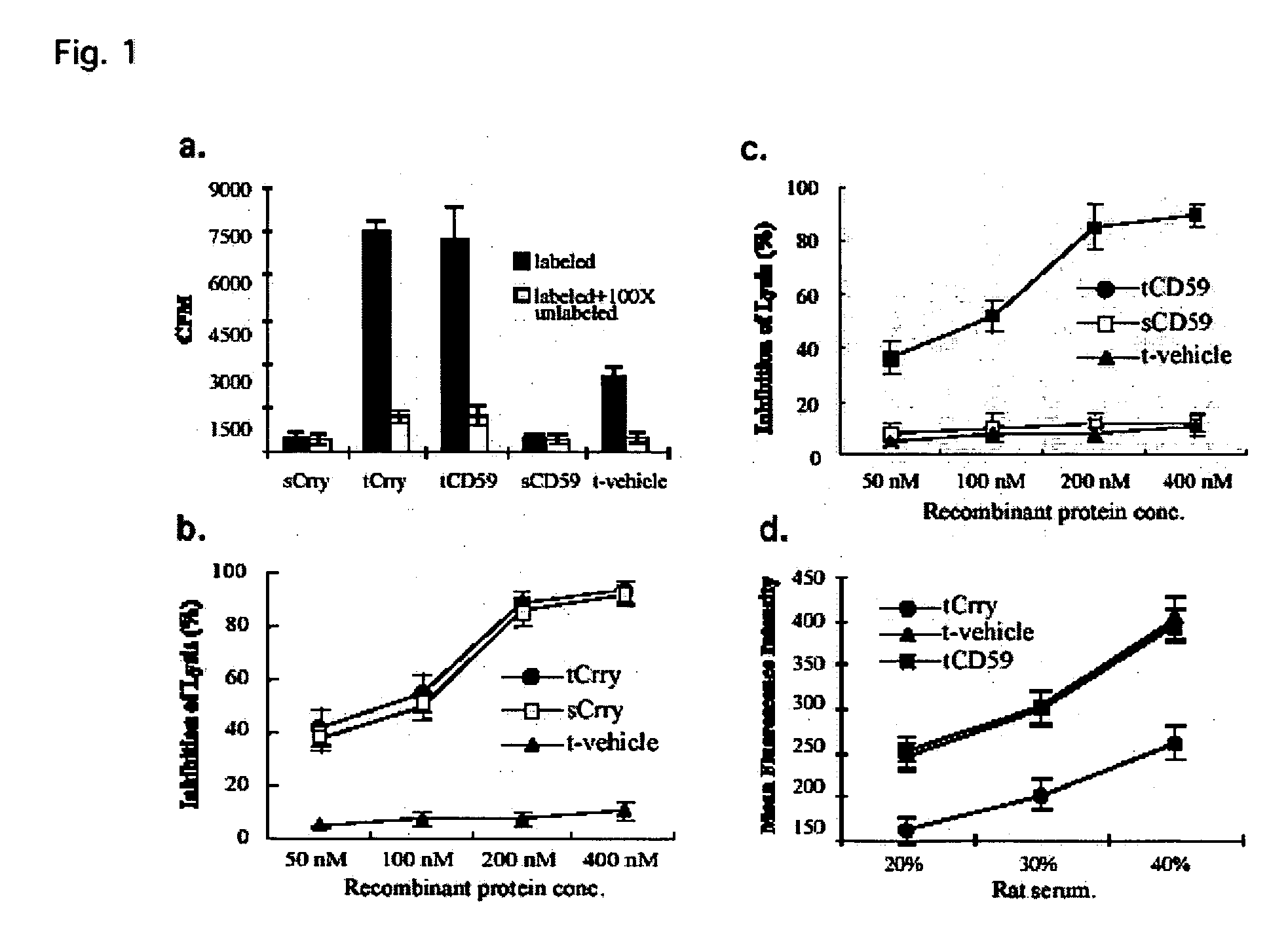Tissue targeted complement modulators
a technology of complement modulators and tissue, applied in the direction of antibody medical ingredients, carrier-bound antigen/hapten ingredients, peptides, etc., can solve the problems of direct cell lysis, indirect cell or tissue destruction, direct cell lysis of complement-mediated cells
- Summary
- Abstract
- Description
- Claims
- Application Information
AI Technical Summary
Benefits of technology
Problems solved by technology
Method used
Image
Examples
example 1
1. Example 1
Complement Inhibitors Targeted to the Proximal Tubule
[0208] a) Results
[0209] In glomerular diseases of diverse etiologies, dysfunction of the glomerular barrier to protein passage results in proteinuria. There is a link between proteinuria and progressive renal damage, and proteinuria is considered an independent risk factor that plays a direct role in interstitial fibrosis and inflammation. The mechanism by which proteinuria leads to nephrotoxic injury is unclear, but an important role for complement in mediating interstitial damage appears likely (1-5). During glomerular proteinuria, complement proteins are present in the glomerular filtrate, and proximal tubular epithelial cells (PTEC) from both rat and human kidneys activate complement (6, 7). There is also evidence that tubular cells are an important local source of complement, and proteinuric filtrate may contain nephrotic factors that activate tubular cells and upregulate expression of complement proteins (4). C...
example 2
2. Example 2
Model Complement Activation in Proteinuric Disease
[0247] The following events of complement activation occurring from the fluid phase are relevant to what occurs in vivo on the PTEC. The initial alternative pathway C3 convertase requires factor D to cleave factor B present in a trimolecular complex containing hydrolyzed C3 (C3(H2O)), factor B, and Mg++. The resulting C3(H2O)Bb can recruit and cleave native C3 to generate alternative pathway C3 and C5 convertases, C3bBb and C3bBbC3b, respectively. This whole process can occur spontaneously because factor D is an active serine esterase (unlike most others that exist as zymogens) while the formation of C3(H2O) is continuous, and can be accelerated by conditions present in tubular fluid, such as exposure to ammonia and acidic pH (28, 51, 57). The generation of C5b-9 can proceed simply when its composite proteins are present in the vicinity. Besides the constraints of component availability, and time and space (that is, the ...
example 3
3. Example 3
mAbs to PTEC Antigens
[0250] It is disclosed herein that PTEC antigens facilitate targeted delivery of CD59 providing protection against the spontaneous formation of C5b-9. In studies, CD59 has been functionally active to prevent C5b-9 generation on cells when targeted to dansyl (15), C3 (16) and DPPIV (44) on the surface of cells. The latter is an intrinsic membrane protein of the PTEC, and it was fortuitous the mAb clone selected (K9 / 9) was effective. DPPIV and iC3b / C3d can be used as targets for mAbs and CR2, respectively. Other potential target antigens include at least 18 members of the solute carrier superfamily present in the PTEC brush border (from Slc1a1 to Slc34a1; see list above), other transporters such as water and chloride channels, and members of the ATP binding cassette family (Abcb1b, Abcc2 and 4). The previously discussed proteins megalin, NEP, and KIM-1, as well as Mucin 20 (MUC20) (68, 69) are also potential target antigens. As noted above, the advant...
PUM
| Property | Measurement | Unit |
|---|---|---|
| time | aaaaa | aaaaa |
| circulatory half life | aaaaa | aaaaa |
| MW | aaaaa | aaaaa |
Abstract
Description
Claims
Application Information
 Login to View More
Login to View More - R&D
- Intellectual Property
- Life Sciences
- Materials
- Tech Scout
- Unparalleled Data Quality
- Higher Quality Content
- 60% Fewer Hallucinations
Browse by: Latest US Patents, China's latest patents, Technical Efficacy Thesaurus, Application Domain, Technology Topic, Popular Technical Reports.
© 2025 PatSnap. All rights reserved.Legal|Privacy policy|Modern Slavery Act Transparency Statement|Sitemap|About US| Contact US: help@patsnap.com



